Top 10 Easy Hydroponic Green Indoor Plants – Perfect for Beginners
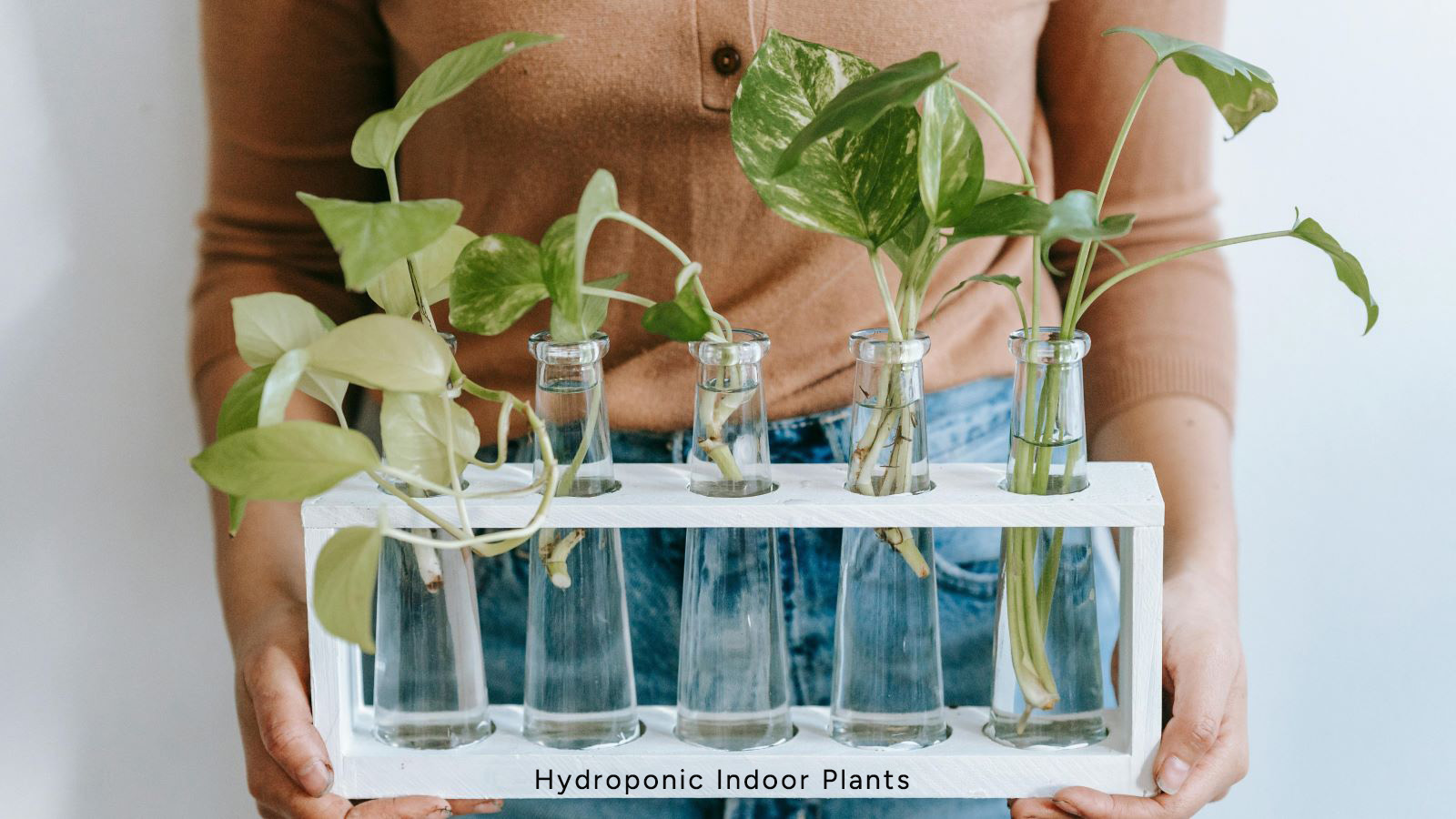
Plants are something that, deep down, no one can really resist. They help us relax, lift our mood, and simply make life feel a little more beautiful. But in reality, most of us live in cities—concrete jungles where we’re constantly rushing around, working, commuting, and barely catching our breath. Sure, there’s greenery here and there in the city, but when was the last time you actually stopped to enjoy it?
That’s why having a few green plants at home can mean so much. They bring a little peace into our hectic lives and offer a simple way to stay connected to nature, even in small moments. So, is it easy to grow plants indoors? Well, that depends on what kind of plants you choose. The great news is: some of them are super easy to care for and can even thrive in just water!
In this post, let’s take a look at 10 indoor plants that are perfect for hydroponic growing—no soil, no mess, just fresh green vibes. They’re low-maintenance, beautiful, and perfect for beginners.
✻ This page may contain affiliate links. If you purchase through these links, we may earn a commission at no extra cost to you. As an Amazon Associate, we earn from qualifying purchases. We only recommend products we believe will add value to our readers.
1. Golden Pothos
Golden Pothos is one of the most popular and beginner-friendly houseplants. You’ll often see it in homes, offices, or anywhere that could use a touch of green.
Nickname: Devil’s Ivy – a plant that’s nearly impossible to kill!
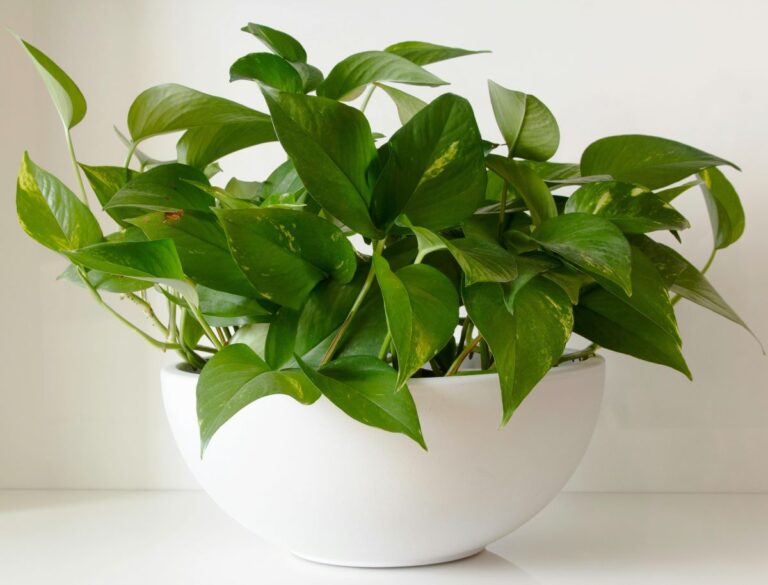
🌱 How to grow it in water:
- Snip a few healthy stems (make sure there’s a node where roots can grow).
- Place them in a clean container with water—just enough to cover the bottom of the stems.
- Add a small drop of liquid fertilizer to give them a little nutrient boost.
- In a few days, you’ll notice new roots starting to grow!
💧 Water change frequency:
- Every 3–5 days at the beginning before the roots appear, to keep the water clean and prevent bacteria buildup that could cause stem rot.
- Once roots are established, you can switch to changing the water about every 10–14 days.
- Don’t forget to top up with a bit of fertilizer every couple of weeks.
🌤 Light tolerance:
- Highly tolerant of low light.
- Thrives in bright, indirect light, but keep it away from direct sun to avoid leaf burn.
Extra tip: Golden Pothos can trail beautifully from shelves or hang in baskets, and it also purifies indoor air.
To help it root faster, keep the environment warm—ideally between 20–25°C (68–77°F). Cooler temperatures can slow down root development.
Golden Pothos is so easy that it feels like everyone has one!
🌿 Ready to start growing? Grab one here➝
2. Lucky Bamboo
Lucky Bamboo is, of course, a type of bamboo, one of the most popular water-grown plants for indoor spaces. It’s easy to care for, visually elegant, and often seen as a symbol of good fortune.
Symbolism: Growth, nobility, and good luck.
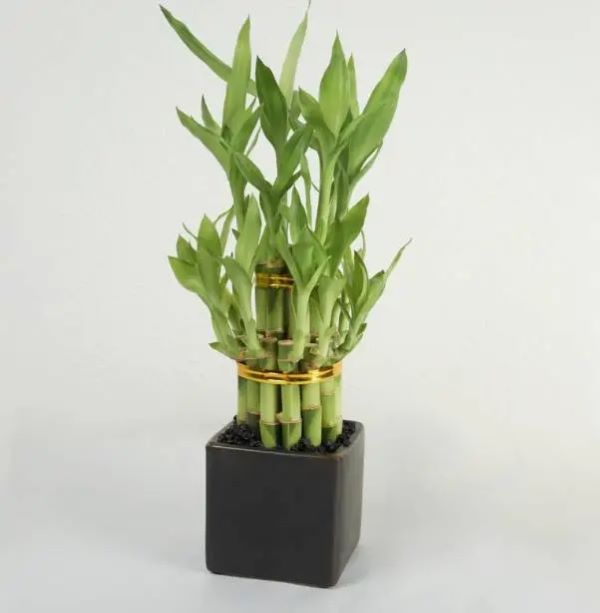
🌱 How to grow it in water:
- Cut a few healthy stalks and remove the leaves (it’s totally fine to keep them leafless at the start).
- Place the cut ends in clean water.
- Add a few drops of liquid fertilizer to help root development.
- Once roots grow out, they’ll thrive in a simple glass container.
💧 Water change frequency:
- Every 3–5 days before roots appear, to keep the water clean and prevent bacteria buildup that could cause stem rot too.
- After rooting, every 10 days is enough.
- Don’t forget to add a bit of fertilizer from time to time.
🌤 Light tolerance:
- Highly tolerant of low light.
- Just place it somewhere with indirect light and decent air circulation.
Extra tip: If you want the roots to grow faster in water, try to keep the temperature between 20–25°C. Lucky Bamboo can be trained into spiral or braided shapes, adding a decorative touch to your home. It’s as easygoing as a Pothos—just water, light, and occasional feeding!
🌿 Ready to start growing? Grab one here➝
3. Pennywort
Pennywort, also known as Hydrocotyle, has become super popular in recent years—especially among plant lovers who enjoy growing in water. You’ll often see it near ponds or streams, but it also thrives indoors in water, making it a perfect semi-aquatic green companion.
Nickname: The easygoing semi-aquatic beauty
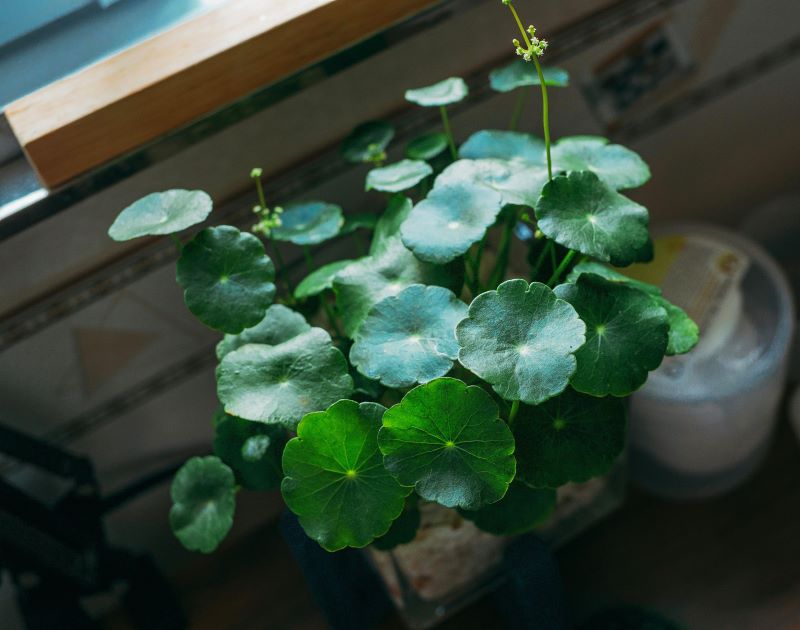
🌱 How to grow it in water:
- Rinse the roots gently and place the plant directly in clean water.
- Add a few drops of liquid fertilizer to support healthy growth.
- Top up the water as it evaporates—there’s no need to change it frequently unless it becomes cloudy or smelly.
- Since it grows quickly, regular trimming helps keep its shape and encourages fuller growth.
💧 Water change frequency:
- Not required frequently—just top up when needed. since It’s a semi-aquatic foliage plant that’s incredibly easy to grow in water.
- Only change the water occasionally, if it looks dirty or starts to smell.
🌤 Light tolerance:
- Prefers bright, indirect light, but it’s quite adaptable.
- Avoid overly dark corners to prevent it from stretching or growing leggy.
Extra tip: Pennywort does well in jars, balconies, or even aquariums. This plant is super low-maintenance and adds a soft, relaxing vibe to any space.
🌿 Ready to start growing? Grab one here➝
4. Peperomia obtusifolia
Peperomia obtusifolia, often called the Baby Rubber Plant, has thick, glossy leaves and a compact shape that makes it perfect for indoor spaces. It’s succulent-like and does surprisingly well in water—yes, even in a small jar on your windowsill!
Nickname: The chubby-leafed charmer
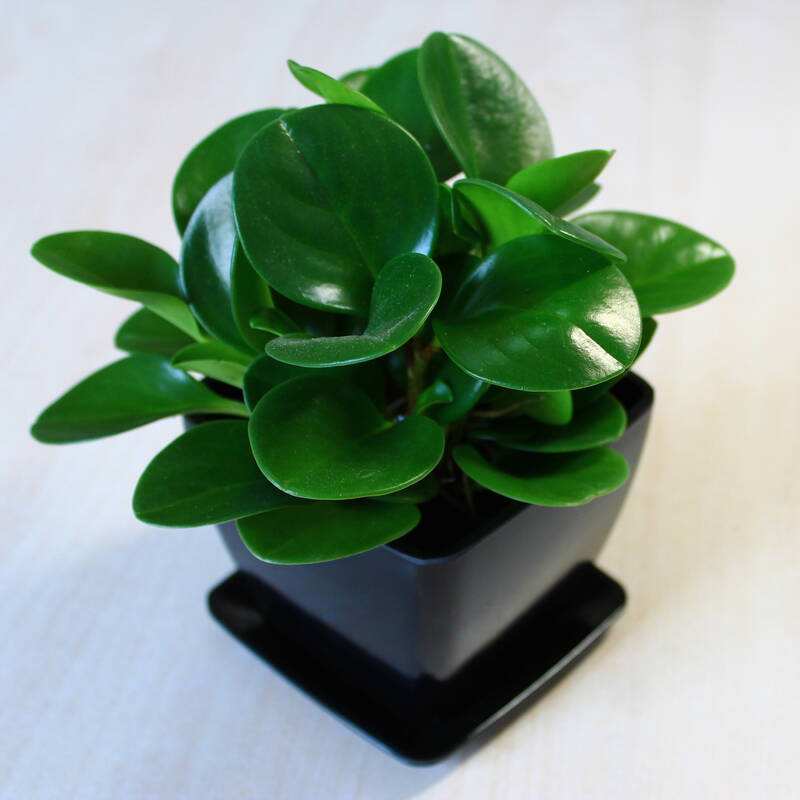
🌱 How to grow it in water:
- You can propagate it from a full stem or even a single healthy leaf (though leaf cuttings take longer).
- Just place the cutting in water, and add a few drops of liquid fertilizer.
- Root development usually takes 2 to 4 weeks, so be patient.
💧 Water change frequency:
- While rooting: change water every 3 days to keep it clean and avoid rotting.
- Once healthy water roots have grown: every 10–15 days is enough—just change it if the water gets cloudy or smells off.
- Add a bit of fertilizer every couple of weeks to support ongoing growth.
🌤 Light tolerance:
- Loves bright, indirect light, but it’s not picky.
- A bright living room, desk, or shaded balcony spot is perfect—just keep it out of harsh direct sunlight.
Extra tip: It’s slow to start but very easy to care for once it’s going. This plant is compact, tidy, and great for beginners who love lush, low-effort greenery.
🌿 Ready to start growing? Grab one here➝
5. Monstera
Monstera is probably one of the most iconic and Instagram-worthy houseplants around—you’ve likely seen its dramatic, split leaves featured in posters, pillows, and home décor. But beyond the aesthetics, it’s also super easy to grow in water.
it is absolutely the internet’s favorite leafy giant.
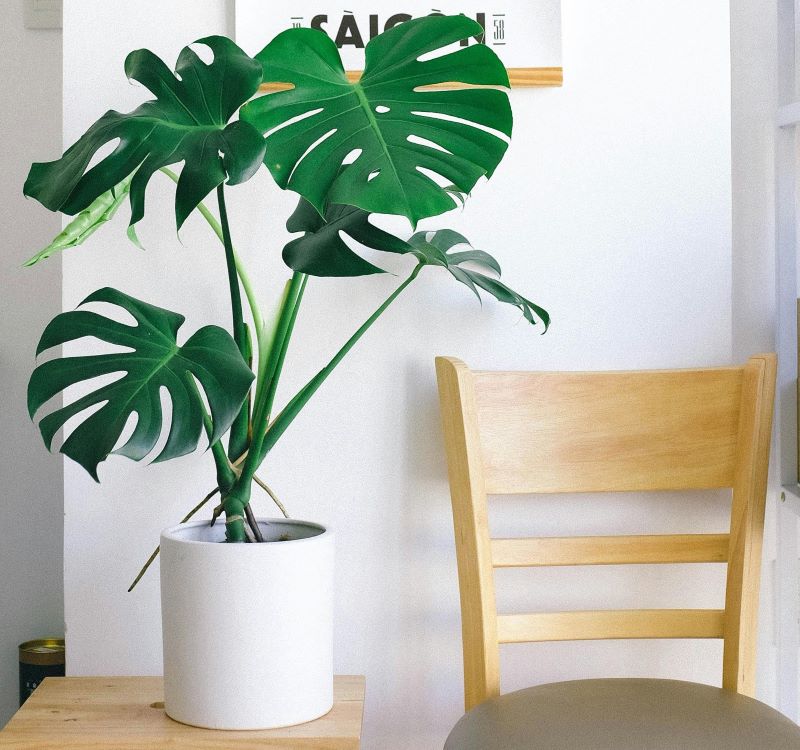
🌱 How to grow it in water:
- Take a healthy stem cutting and rinse the roots thoroughly, removing any leftover soil.
- Snip off older soil roots if needed—they don’t adapt well to water.
- Place the stem in a container and add just enough water to cover the roots (not the whole stem).
- Add a little liquid fertilizer to support growth.
💧 Water change frequency:
- Early stage (before water roots form): change water every 3–4 days to avoid bacteria buildup.
- After white water roots appear: switch to once a week, or whenever the water looks cloudy.
🌤 Light tolerance:
- Tolerates low light, but thrives in bright, indirect sunlight.
- Place it near a window, balcony, or any well-lit corner—just avoid direct harsh sun that can scorch the leaves.
Extra tip: Keep the room warm (around 20–25°C) to help it root and grow faster. With just a little care, Monstera can become the bold, tropical statement plant in your indoor jungle—even in a simple water-filled vase!
🌿 Ready to start growing? Grab one here➝
6. Spider Plant (Chlorophytum comosum)
Spider Plant gets its name from the way its long, trailing leaves and baby offshoots “dangle” like little spiders—perfect for hanging pots or wall shelves. It’s not just pretty; it also symbolizes hope and calmness, making it a popular pick for peaceful home vibes.
Nickname: The hanging green charm.

🌱 How to grow it in water:
- Take a healthy spiderette (the baby plant from the mother), trim off any damaged roots, and place it in a clear glass container so you can watch the roots grow.
- Use enough clean water to cover the roots—but not the whole base of the plant.
💧 Water change frequency:
- Summer: change water every 4–5 days to keep it fresh and oxygenated.
- Winter: change water about once a week, and spray the leaves with water on sunny days to keep them hydrated.
- Fertilizer: not much is needed—just add a little diluted liquid fertilizer once a month during the growing season.
🌤 Light tolerance:
- Likes partial shade or indirect sunlight.
- Avoid strong midday sun in summer, and keep it somewhere bright but not too hot.
- In winter, just make sure the temperature stays above 7°C (44°F) and give it occasional sunshine.
Extra tip: Some people even grow spider plants in aquariums or fish tanks—they’re that adaptable! The roots help purify the water while the leaves add greenery above. A fun and eco-friendly combo!
🌿 Ready to start growing? Grab one here➝
7. Parlor Palm (Chamaedorea elegans)
Native to Mexico, the Parlor Palm gets its name from its common spot in traditional living rooms (“parlors”). With its miniature palm-tree look, it brings a soft, tropical vibe into any space—while being surprisingly easy to grow in water!
Nickname: The living room classic
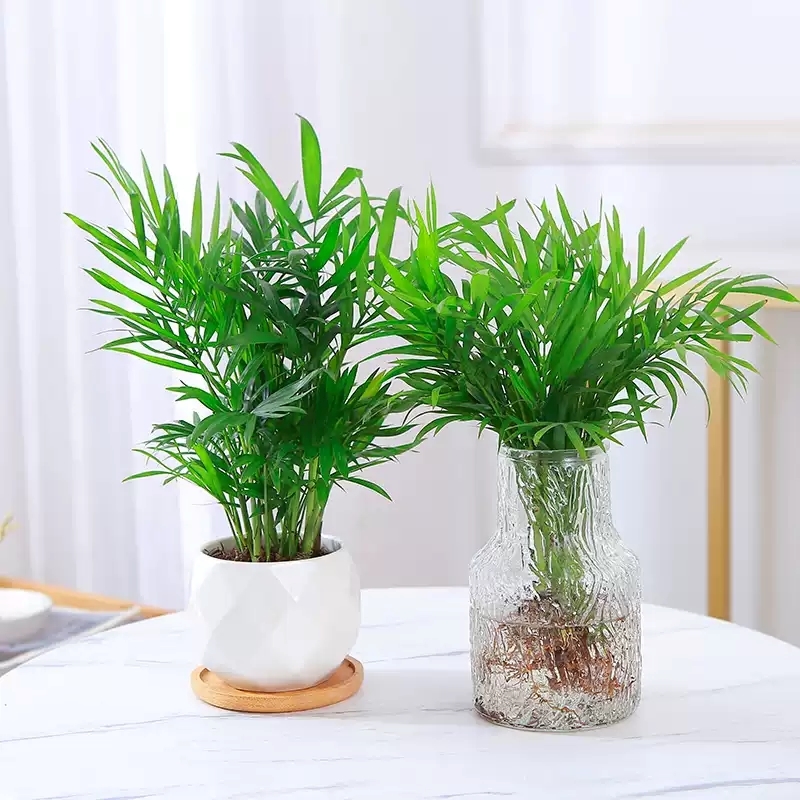
🌴 How to grow it in water:
- Use a medium-sized container—not too wide—to help hold the plant upright while allowing for root growth.
- Rinse off any soil from the roots and place them in clean water.
- Add a small amount of liquid fertilizer to support growth.
💧 Water change frequency:
- Early stage (summer): change water twice a week.
- Once established: reduce to once a week.
- In winter: change water every 10–15 days.
🌤 Light tolerance:
- Very shade-tolerant, but it still enjoys warm, soft, indirect light.
- Avoid placing it in strong direct sun, which can scorch the delicate fronds.
Extra care tips: In dry weather or heated indoor spaces, mist the leaves occasionally to maintain humidity and prevent drying. Parlor Palm is not only elegant but also super beginner-friendly—perfect for adding a touch of green grace to your living room shelf or side table.
🌿 Ready to start growing? Grab one here➝
8. Schefflera (Umbrella Plant)
Schefflera, often called the Umbrella Plant, gets its cute nickname from its unique leaf shape—each leaflet fans out like the spokes of a tiny green umbrella (or duck feet, depending on who you ask!). It’s a super easy plant to grow in water and adds instant tropical flair to any room.
Symbolizing protection, harmony, and steady growth, the Umbrella Plant is a great addition to any space seeking calm, green energy.
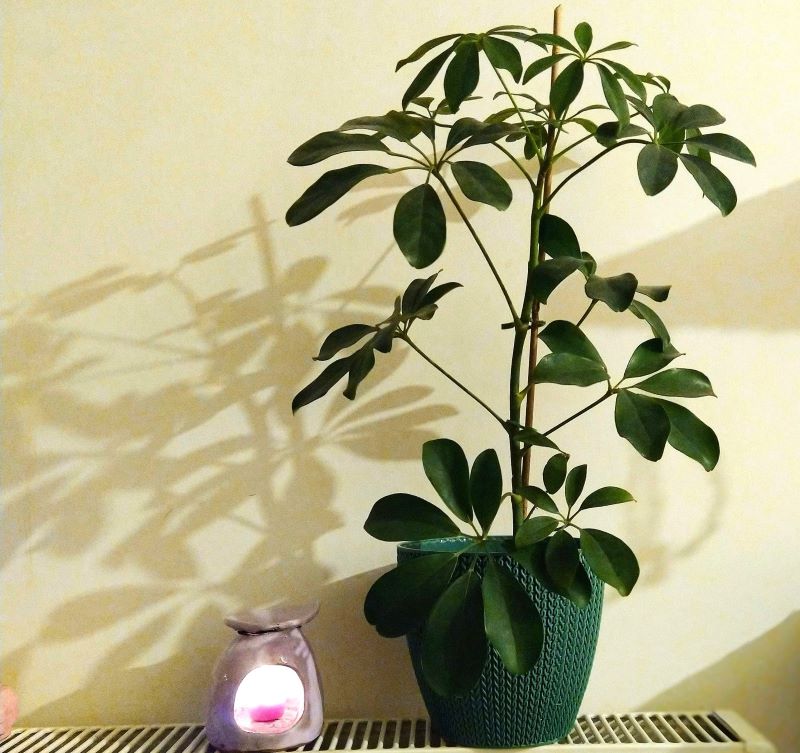
🌱 How to grow it in water:
- Snip a few healthy stems (about 10–15 cm long), and trim off most of the lower leaves.
- Place the bare part of the stems in clean water.
- Add a bit of liquid plant nutrients to encourage root growth.
💧 Water change frequency:
- First few weeks: change water every 3–4 days to keep it fresh and bacteria-free.
- After roots develop: change water every 1–2 weeks or whenever it starts to look cloudy.
🌤 Light tolerance:
- Loves bright, indirect light—a sunny windowsill (with filtered light) works great.
- If the sunlight is strong, just mist the leaves more often to keep them fresh.
- In fact, Schefflera is often planted outdoors as a hedge in parks—so don’t worry too much about sun exposure.
Extra tips: Mist the leaves regularly to keep them hydrated and dust-free, especially in dry indoor air. Keep the temperature above 15°C for best growth. Schefflera is low-maintenance, stylish, and great for beginners—especially if you like bold greenery with minimal soil mess!
🌿 Ready to start growing? Grab one here➝
9. Nageia nagi (bamboo pine)
Nageia nagi, Also known as “bamboo pine” in China, this plant is actually an evergreen tree with bamboo-like leaves and a pine-like trunk. It’s often called a living fossil, It is commonly used in landscaping and as a potted ornamental plant.
Symbolizing health, longevity, and noble character.
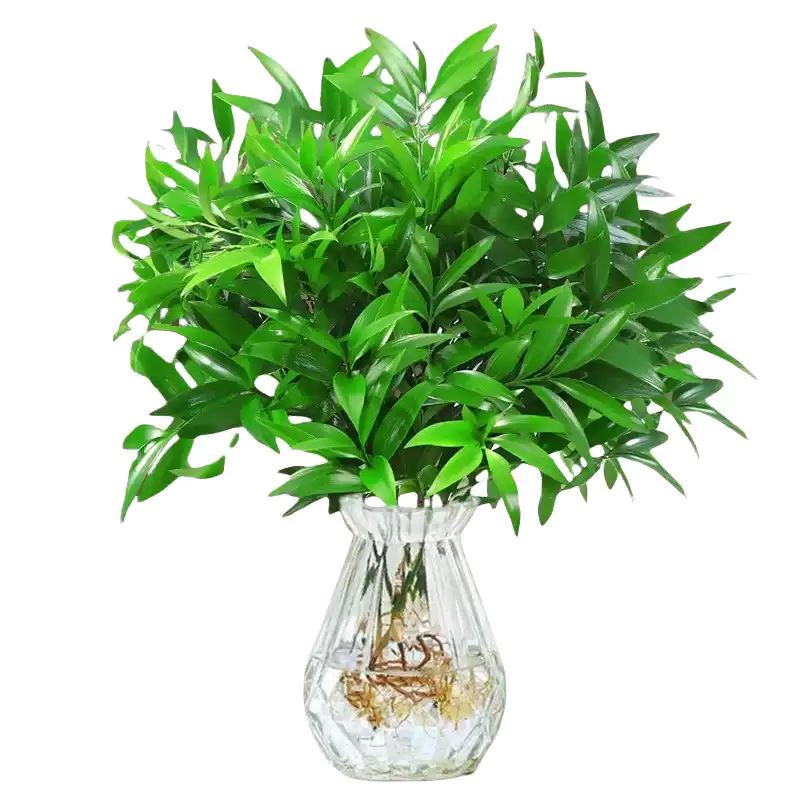
Even though it’s technically a tree, bamboo pine is surprisingly well-suited for hydroponics and super beginner-friendly.
🎋 How to grow it in water:
- Add a bit of diluted nutrient solution, and you’re good to go!
- Rinse the whole plant thoroughly—including the roots—to remove any soil.
- Trim the root ends slightly to help with water absorption.
- Place the base into water, making sure only the roots are submerged.
💧 Water change frequency:
- Change the water once a week, and clean the container to keep things fresh.
- Every two weeks, add a small amount of liquid fertilizer (a diluted nutrient solution is perfect).
☀️ Light Tolerance:
- It’s shade-tolerant, but still needs a bit of soft sunlight now and then.
- Place it in a bright indoor spot like your living room, balcony, or near a window.
- Avoid harsh direct sunlight, which might cause leaf burn, mist the leaves more often to keep them fresh
✅ Why you’ll love it:
A low-maintenance, elegant plant that’s perfect for adding some zen vibes—even if you’re a total beginner!
🌿 Ready to start growing? Grab one here➝
10. Philodendron Congo
Philodendron Congo is a tropical plant known for its rich, glossy foliage and great shade tolerance—making it perfect for growing in water, even for beginners!
Nickname: The shade-tolerant beauty
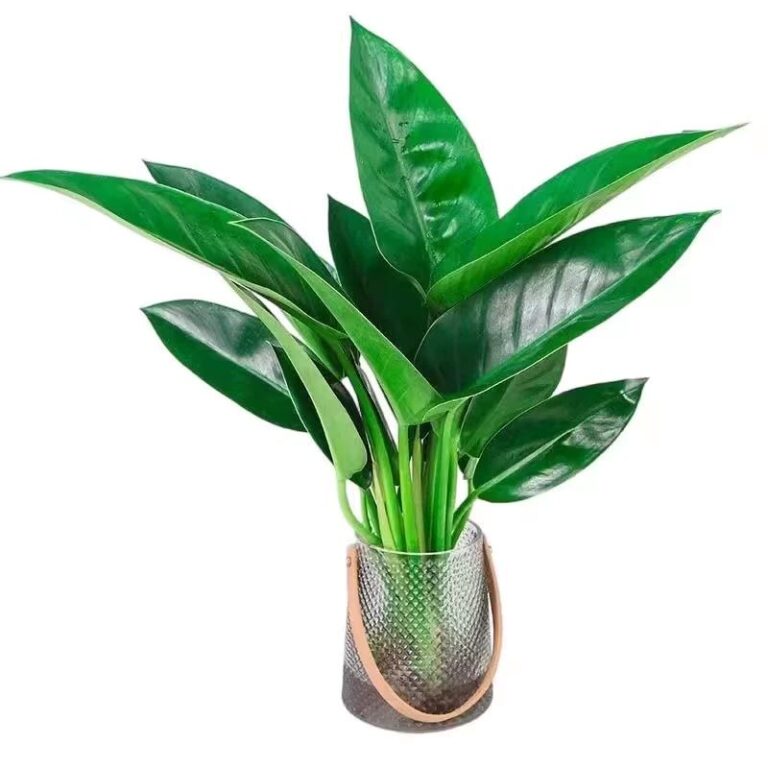
🌱 How to grow it in water:
- Cut a few healthy stems, and place them in a container with water.
- Add a bit of liquid plant nutrients to promote root growth.
💧 Water change frequency:
- Early stages: change the water every 2–3 days to keep it clean and encourage root development.
- Once roots are established: reduce water changes to every 1–2 weeks, and add nutrients as needed to keep the plant healthy.
🌤 Light tolerance:
- Low light tolerance, but it still requires indirect sunlight for photosynthesis and overall health.
- Avoid placing it in strong direct sunlight, which can cause leaf burn.
Extra tips: Philodendron Congo thrives in bright, spacious areas, such as a living room or hallway. Keep it humid by misting the leaves or placing it near a humidifier if you live in a dry climate. It’s very forgiving, but keep an eye on the water level and change it when it starts to look murky.
🌿 Ready to start growing? Grab one here➝
Final Thougth for Hydroponic Indoor Plants
There are actually many more hydroponic plants out there, but the ones we’ve covered in this article are some of the easiest to care for, making them perfect for beginners. If you have any other recommendations, feel free to leave them in the comments!
With the development of modern technology, there are now smart hydroponic systems that make growing plants even easier. All you have to do is place your seeds, seedlings, or cuttings into the system, turn it on, and it will automatically grow healthy, thriving plants.
Whether you stick to traditional methods or try out the latest tech, growing green plants at home brings fresh air and natural beauty to any space.




